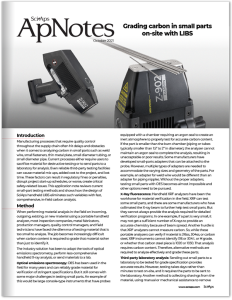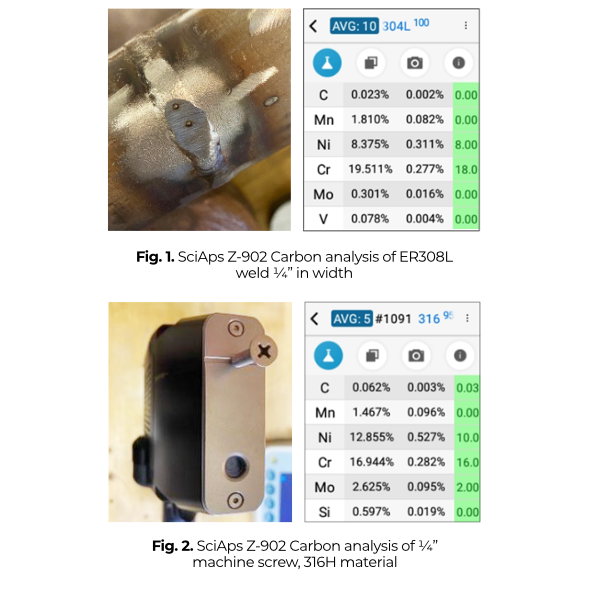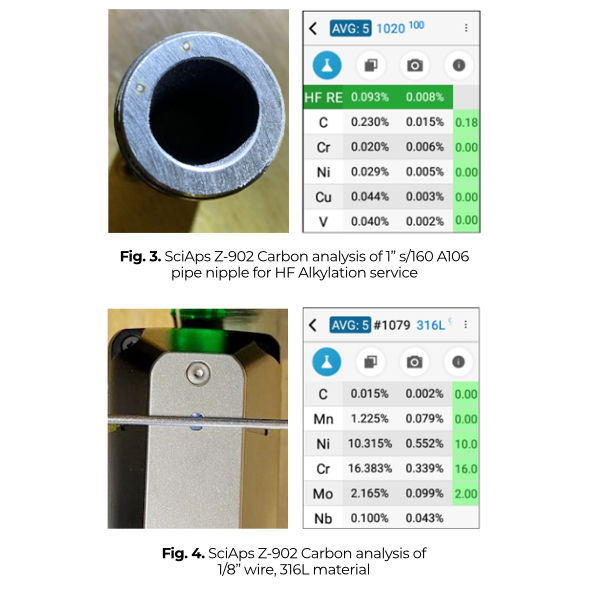Positive Material Identification (PMI)
Analyze carbon in small parts on-site using handheld LIBS
Published on 31st December 2021

A comprehensive material verification program includes testing weld wire, round bar, small bore pipe and bolting. All SciAps LIBS analyzers are designed to optimize access to such parts, providing a comprehensive, on-site solution for QA/QC programs.
Need to analyze carbon content in small parts?
Analyzing carbon content in small parts has always been a challenge due to the limitations in spark OES technology.
Because it is difficult or impossible to analyze small parts with mobile spark OES, users must sacrifice material for destructive laboratory for analysis. Even reliable third-party testing facilities can mean material mix ups, added cost to the project, and lost time. These factors can cost you or your customer regulatory fines or penalties, impact critical project start-up schedules, or worse, create critical safety-related issues.
Instead of dealing with the headache of collecting shavings, sending out material to a third-party laboratory, or having to attach various adapters to your analyzers, SciAps has a proven solution for your QA/QC program.
The SciAps LIBS unit is especially designed for handling curved surfaces and small parts. The device uses a small exit aperture and patented argon purge/bleed design so that a good purge is achieved without requiring a seal to the material surface. The laser beam, unlike spark, is only about 100 um in diameter, and easily analyzes small spot locations.
Introduction
Manufacturing processes that require quality control throughout the supply chain often hit delays and obstacles when it comes to analyzing carbon in small parts such as weld wire, small fasteners, thin metal plate, small diameter tubing, or small diameter pipe. Current processes either require users to sacrifice material for destructive testing or to send parts to a laboratory for analysis. Even reliable third-party testing facilities can cause material mix ups, added cost to the project, and lost time. These factors can result in regulatory fines or penalties, disrupt project start-up schedules, or worse, create critical safety-related issues. This application note reviews current small-part testing methods and shows how the design of SciAps handheld LIBS eliminates such variables with fast, comprehensive, in-field carbon analysis.

Method
When performing material analysis in the field on incoming, outgoing, existing, or new material using a portable handheld analyzer, most inspection companies, metal fabricators, production managers, quality control managers, and field technicians have faced the dilemma of testing for carbon content in material that is too small to analyze. The job becomes increasingly difficult when carbon content is required to grade that material rather than just to identify it.
To date, the industry solution has been to adapt the tools of optical emissions spectrometry, perform less-comprehensive handheld X-ray analysis, or send materials to a lab.
Optical emissions spectroscopy: OES has been used in the field for many years and can reliably grade material for verification of stringent specifications. But it still comes with some major challenges in testing small parts. An example of this would be large console-type instruments that have probes equipped with a chamber requiring an argon seal to create an inert atmosphere to properly test for accurate carbon content. If the part is smaller than the burn chamber (piping or tubes typically smaller than 1.5” to 2” in diameter), the analyzer cannot maintain an argon seal to complete the analysis, resulting in unacceptable or poor results. Some manufacturers have developed small-parts adapters that can be attached to the probe. However, multiple types of adapters are needed to accommodate the varying sizes and geometry of the parts. For example, an adapter for weld wire would be different than an adapter for piping nipples. Without the proper adapters, testing small parts with OES becomes almost impossible and other options need to be pursued.
X-Ray fluorescence: Handheld XRF analyzers have been the workhorse for material verification in the field. XRF can test some small parts, and there are some manufacturers who have collimated the X-ray beam to further help test small parts. But they cannot always provide the analysis required for detailed verification programs. In one example, if a part is very small, it may not get a sufficient number of X-rays to provide an accurate chemistry because of beam spread. Another hurdle is that XRF analyzers cannot measure carbon. So, while these portable analyzers can verify if material is 316ss, 304ss, or carbon steel, XRF instruments cannot identify 316 or 304 L or H grade, or whether that carbon steel piece is 1020 or 1030. That analysis requires carbon content. Therefore, alternative methods are required to analyze effectively and grade these parts.
Third-party laboratory analysis: Sending out small parts to a laboratory to be tested for grade specification provides accurate results. However, testing takes days rather than minutes to test on-site, and it requires the parts to be sent to the laboratory. Another method is collecting shavings from the material, using manual or mechanical assistance to remove small amounts of material to send to a laboratory. This method allows the producer to keep original parts on site, but it still requires a delay.
SciAps handheld LIBS provides a new method derived from an established laboratory laser technique with many similarities to OES. Where OES uses a continuous electric spark as its excitation source, LIBS fires a pulsed laser at the material to create a plasma. An on-board spectrometer measures light from the plasma and individual wavelengths to reveal elemental content, which is quantified via on-board calibrations. In moving this technique to a handheld, SciAps LIBS analyzers provide a comprehensive solution for in-field materials verification that includes carbon analysis. SciAps LIBS instruments additionally feature a small exit aperture and patented design so that a good purge is achieved without requiring a seal to curved surfaces or small parts.
SciAps handheld LIBS can test parts smaller than the burn chamber, with no adapters required. Once the sample surface is prepared and the small part is lined up with the internal camera, a focused laser ablates the material and produces the plasma. The test area is approximately 50 microns (about the diameter of a single hair), which can easily accommodate even the smallest of parts. In comparison, conventional OES requires a very large area (about the diameter of a quarter) and an argon seal to complete the testing.
Data and Discussion

Fig. 1. SciAps Z-902 Carbon analysis of ER308L weld 1⁄4” in width.
Fig. 2. SciAps Z-902 Carbon analysis of 1⁄4” machine screw, 316H material.

Fig. 3. SciAps Z-902 Carbon analysis of 1” s/160 A106 pipe nipple for HF Alkylation service.
Fig. 4. SciAps Z-902 Carbon analysis of 1/8” wire, 316L material.
API Recommended Practice 578: “The owner/user shall establish a written material verification program indicating the extent and type of PMI to be conducted during the construction of new assets, retroactively on existing assets, and during the maintenance, repair, or alteration of existing assets. For higher‐risk systems, the owner/user should consider the need for employing a higher extent of examination (up to 100%) rather than random sampling which may be more appropriate for lower‐risk systems.”
Deploying a comprehensive material verification program includes testing weld wire, round bar, small bore pipe and bolting. All SciAps LIBS analyzers are designed to optimize access to such parts. The days of rubber gaskets that tear and bulky external bolt-on adapters are over. Testing for carbon content in L and H grade stainless is now easy, convenient, and productive.
Summary
Instead of dealing with the headache of collecting shavings, sending out material to a third-party laboratory, or having to collect and attach various adapters, SciAps provides a comprehensive, on-site solution for carbon analysis in QA/QC programs using handheld LIBS.
Especially designed for curved surfaces and small parts, with a small exit aperture and patented argon purge/bleed design that requires no seal to the material surface, SciAps LIBS provides greater inspection coverage of critical assets. This includes even the smaller pressure-retaining items that too often get passed over due to their smaller size or challenging geometry.
In conclusion, SciAps has provided the industry with an efficient, cost-effective solution to analyze all critical components instantly, including the small parts that are so commonly left out of the testing process or have been a burden to verify.









